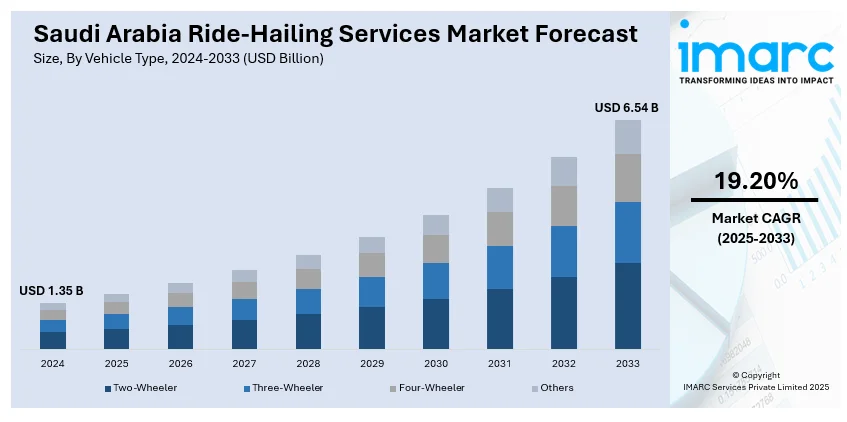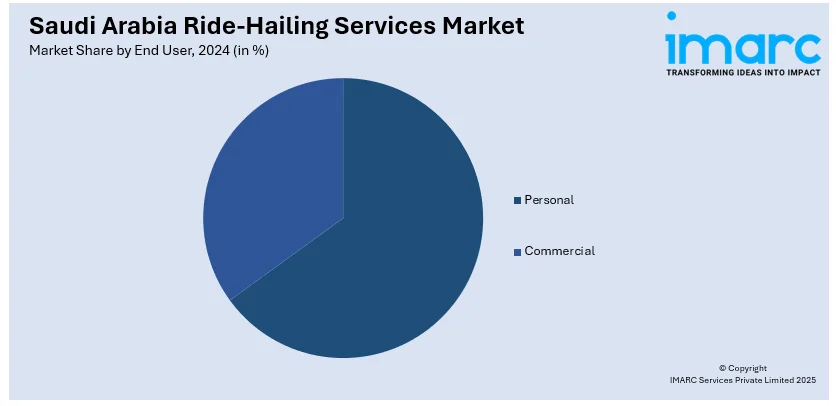
Saudi Arabia Ride-Hailing Services Market Size, Share, Trends and Forecast by Vehicle Type, Service Type, Payment Method, Location Type, End User, and Region, 2025-2033
Saudi Arabia Ride-Hailing Services Market Overview:
The Saudi Arabia ride-hailing services market size reached USD 1.35 Billion in 2024. Looking forward, IMARC Group expects the market to reach USD 6.54 Billion by 2033, exhibiting a growth rate (CAGR) of 19.20% during 2025-2033. The market is experiencing gradual growth, predominantly fueled by growth in urbanization, smartphone penetration, and supportive government policies. Additionally, increased regulatory structures and growing demand for convenient transport also contribute to growth, placing the industry in position for long-term development over the next few years.
|
Report Attribute
|
Key Statistics
|
|---|---|
|
Base Year
|
2024 |
|
Forecast Years
|
2025-2033
|
|
Historical Years
|
2019-2024
|
| Market Size in 2024 | USD 1.35 Billion |
| Market Forecast in 2033 | USD 6.54 Billion |
| Market Growth Rate (2025-2033) | 19.20% |
Saudi Arabia Ride-Hailing Services Market Trends:
Magnifying Smartphone Ownership and Digital Penetration
With the rise in smartphone adoption and internet connectivity, digital penetration in Saudi Arabia is significantly boosting the ride-hailing sector. For instance, as per industry reports, in 2024, approximately 33.55 million individuals in Saudi Arabia owned a smartphone, with this figure projected to increase to 36.55 million by 2028. The widespread availability of affordable smartphones and the government’s focus on advancing digital infrastructure have created an environment that favors mobile-based services. Additionally, the trend is also consistent with nation's digitalization goals, enabling ride-hailing businesses to appeal to a mobile-first, technology-embracing population. To this, aside from this, integrating with digital payment platforms eases transactions, boosting user experience and driving the demand for on-demand transport, especially among youth.

Increasing Government Aid and Regulatory Transformation
Saudi Arabia’s regulatory environment is evolving rapidly to accommodate and support the ride-hailing industry. The government’s initiatives, such as issuing clear guidelines and licensing requirements for ride-hailing companies, provide a structured framework that encourages market entry and competition. Moreover, this support also helps establish higher safety standards, which enhances customer trust. In addition to this, by enabling smoother operations for local and international players, these regulatory measures are anticipated to attract more investment and foster innovation within the sector, promoting sustainable market growth. For instance, as per industry reports, in February 2024, the Transport General Authority (TGA) implemented regulations aimed at improving service quality and boosting investments in Saudi Arabia's ride-hailing sector by enhancing operational efficiency. Key requirements include mandatory subscription to the Interior Ministry’s Shomoos system for inter-city rides, visibility of trip destinations for drivers before acceptance, and removal of ID barcode/tag obligations in vehicles, among other beneficial updates.
Rising Preference for Flexible and Sustainable Transportation
As environmental awareness is rapidly escalating, a significant inclination towards flexible as well as sustainable transportation solutions is actively being observed within the Saudi Arabia ride-hailing market. Customers are currently favoring services like carpooling, ride-sharing, and electric or hybrid vehicle options that can substantially minimize reduce carbon emissions. For instance, as per industry reports, 83.5% men and 16.5% women in Saudi Arabia uses transportation apps for services such as ridesharing. Consequently, ride-hailing companies are actively responding to this rising preference by integrating environmentally friendly fleet choices and endorsing shared rides, addressing the global sustainability trends. Moreover, this trend aligns with Saudi Arabia’s inclusive sustainability objectives, and as the requirement for greener substitutes elevates, it provides opportunities for ride-hailing service providers to proliferate their offerings by fostering environmental initiatives.
Saudi Arabia Ride-Hailing Services Market Segmentation:
IMARC Group provides an analysis of the key trends in each segment of the market, along with forecasts at the region level for 2025-2033. Our report has categorized the market based on vehicle type, service type, payment method, location type, and end user.
Vehicle Type Insights:
- Two-Wheeler
- Three-Wheeler
- Four-Wheeler
- Others
The report has provided a detailed breakup and analysis of the market based on the vehicle type. This includes two-wheeler, three-wheeler, four-wheeler and others.
Service Type Insights:
- E-hailing
- Car Sharing
- Car Rental
- Others
The report has provided a detailed breakup and analysis of the market based on the service type. This includes e-hailing, car sharing, car rental and others.
Payment Method Insights:
- Cash
- Online
A detailed breakup and analysis of the market based on the payment method have also been provided in the report. This includes cash, and online.
Location Type Insights:
- Urban
- Rural
A detailed breakup and analysis of the market based on the location type have also been provided in the report. This includes urban, and rural.
End User Insights:

- Personal
- Commercial
The report has provided a detailed breakup and analysis of the market based on the end user. This includes personal, and commercial.
Regional Insights:
- Northern and Central Region
- Western Region
- Eastern Region
- Southern Region
The report has also provided a comprehensive analysis of all the major regional markets, which include Northern and Central, Western, Eastern, and Southern Region.
Competitive Landscape:
The market research report has also provided a comprehensive analysis of the competitive landscape. Competitive analysis such as market structure, key player positioning, top winning strategies, competitive dashboard, and company evaluation quadrant has been covered in the report. Also, detailed profiles of all major companies have been provided.
Saudi Arabia Ride-Hailing Services Market News:
- In February 2023, Ego, a Riyadh, Saudi-Arabia headquartered ride-hailing app, unveiled a strategic tie-up with MoEngage, a leading AI platform to create data-driven strategic decisions and planning. Ego will leverage MoEngage as the central platform for all messages, using its ability to track optimal timing and channels for messages, with an emphasis on boosting retention and optimising customer lifetime value.
- In February 2024, Tasaru Mobility Investments, an investment firm based in Saudi Arabia, announced it will strategically buy a 38% minority stake in Holon, which is a Benteler subsidiary, with the goal of expanding its fully electric and autonomous vehicle sales. It will include opening a production facility in Saudi Arabia to serve local ride-hailing and ride-pooling operations, furthering the kingdom's vision for sustainable mobility.
- In April 2024, Uber, a major ride-hailing application, launched Uber Teen Accounts in Saudi Arabia, enabling parents or guardians to set up dedicated accounts for teens aged 13-17. This feature allows teens to request rides independently while ensuring parental oversight and integrating essential safety measures.
Saudi Arabia Ride-Hailing Services Market Report Coverage:
| Report Features | Details |
|---|---|
| Base Year of the Analysis | 2024 |
| Historical Period | 2019-2024 |
| Forecast Period | 2025-2033 |
| Units | Billion USD |
| Scope of the Report |
Exploration of Historical Trends and Market Outlook, Industry Catalysts and Challenges, Segment-Wise Historical and Future Market Assessment:
|
| Vehicle Types Covered | Two-Wheeler, Three-Wheeler, Four-Wheeler, Others |
| Service Types Covered | E-hailing, Car Sharing, Car Rental, Others |
| Payment Methods Covered | Cash, Online |
| Location Types Covered | Urban, Rural |
| End Users Covered | Personal, Commercial |
| Regions Covered | Northern and Central Region, Western Region, Eastern Region, Southern Region |
| Customization Scope | 10% Free Customization |
| Post-Sale Analyst Support | 10-12 Weeks |
| Delivery Format | PDF and Excel through Email (We can also provide the editable version of the report in PPT/Word format on special request) |
Key Questions Answered in This Report:
- How has the Saudi Arabia ride-hailing services market performed so far and how will it perform in the coming years?
- What is the breakup of the Saudi Arabia ride-hailing services market on the basis of vehicle type?
- What is the breakup of the Saudi Arabia ride-hailing services market on the basis of service type?
- What is the breakup of the Saudi Arabia ride-hailing services market on the basis of payment method?
- What is the breakup of the Saudi Arabia ride-hailing services market on the basis of location type?
- What is the breakup of the Saudi Arabia ride-hailing services market on the basis of end user?
- What is the breakup of the Saudi Arabia ride-hailing services market on the basis of region?
- What are the various stages in the value chain of the Saudi Arabia ride-hailing services market?
- What are the key driving factors and challenges in the Saudi Arabia ride-hailing services market?
- What is the structure of the Saudi Arabia ride-hailing services market and who are the key players?
- What is the degree of competition in the Saudi Arabia ride-hailing services market?
Key Benefits for Stakeholders:
- IMARC’s industry report offers a comprehensive quantitative analysis of various market segments, historical and current market trends, market forecasts, and dynamics of the Saudi Arabia ride-hailing services market from 2019-2033.
- The research report provides the latest information on the market drivers, challenges, and opportunities in the Saudi Arabia ride-hailing services market.
- Porter's five forces analysis assist stakeholders in assessing the impact of new entrants, competitive rivalry, supplier power, buyer power, and the threat of substitution. It helps stakeholders to analyze the level of competition within the Saudi Arabia ride-hailing services industry and its attractiveness.
- Competitive landscape allows stakeholders to understand their competitive environment and provides an insight into the current positions of key players in the market.
Need more help?
- Speak to our experienced analysts for insights on the current market scenarios.
- Include additional segments and countries to customize the report as per your requirement.
- Gain an unparalleled competitive advantage in your domain by understanding how to utilize the report and positively impacting your operations and revenue.
- For further assistance, please connect with our analysts.
 Inquire Before Buying
Inquire Before Buying
 Speak to an Analyst
Speak to an Analyst
 Request Brochure
Request Brochure
 Request Customization
Request Customization




.webp)




.webp)












